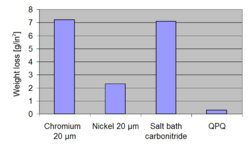Quench polish quench (QPQ) is a specialized type of nitrocarburizing case hardening that increases corrosion resistance. It is sometimes known by the brand name of Tufftride, Tenifer or Melonite. Three steps are involved: nitrocarburize ("quench"), polish, and post-oxidize ("quench").
This process is often used when two or more of the following properties are required in a workpiece:
Common applications of the process are for piston rods of shock absorbers, cylinders and rods for hydraulic systems, pumps, axles, spindles, firearm slides and barrels and valves.
Process
The process starts with a standard salt bath nitrocarburizing cycle, which produces a layer of ε iron nitride. Next, the workpiece is mechanically polished; typical polishing processes include vibratory finishing, lapping, and centerless grinding. Finally, the workpiece is re-immersed into the salt quench bath for 20 to 30 minutes, rinsed, and oil dipped. This last step optimizes the corrosion resistance by creating a layer of iron oxide about 3 to 4 micrometers thick. It also gives the workpiece a black finish.
Corrosion resistance
Field immersion


The chart on the right shows a comparison of corrosion resistance against other surface treatments, based on field immersion tests. Test conditions for the immersion test are full immersion in 3% sodium chloride plus 3 g /L of hydrogen peroxide for 24 hours.
Salt spray test
The chart on the right shows a comparison of the corrosion resistance of surface treated steel automotive steering columns based on the ASTM B117 salt spray test.
See also
References
- "Melonite/QPQ". HEF Group (USA). 14 June 2012. Retrieved 16 February 2014.
- Davis, Joseph R., ed. (2002). Surface Hardening of Steels: Understanding the Basics. ASM International. pp. 203–204. ISBN 9781615032501. Retrieved 16 February 2014.
- ^ Easterday, James R. (1996). "The Kolene QPQ(SM) Process". Detroit, Michigan: Kolene Corporation. Retrieved 14 February 2014.
- Liapina, T.; Leineweber, A.; Mittemeijer, E. J. (June 2003). "Nitrogen redistribution in ε/γ′-iron nitride compound layers upon annealing". Scripta Materialia. 48 (12). Elsevier: 1643–1648. doi:10.1016/s1359-6462(03)00136-2.(subscription required)
- "Use Salt Bath Nitriding for Uniform & Consistent Layers". Kennebunk, Maine: Northeast Coating. Retrieved 16 February 2014.
- "QPQ Liquid Nitriding". Edmonton, Alberta: Thermex Metal Treating Ltd. 2010. Retrieved 16 February 2014.
External links
| Iron and steel production | |||||||||
|---|---|---|---|---|---|---|---|---|---|
| Iron production (Ironworks) |
|  | |||||||
| Steelmaking (Steel mill) |
| ||||||||
| Heat treatment methods |
| ||||||||
| Production by country | |||||||||